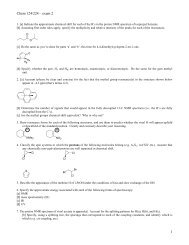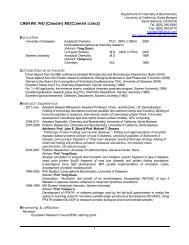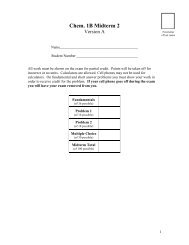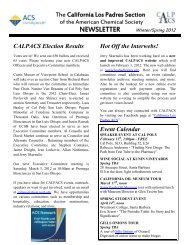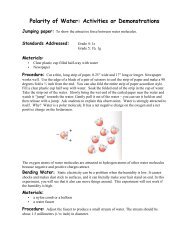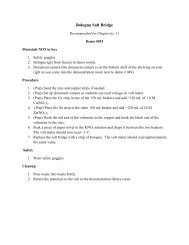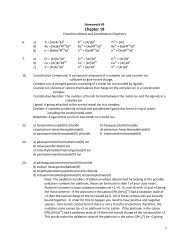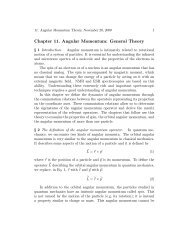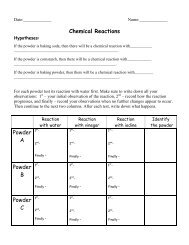Chemistry 1C/1CL Tentative Lecture and Laboratory Schedule ...
Chemistry 1C/1CL Tentative Lecture and Laboratory Schedule ...
Chemistry 1C/1CL Tentative Lecture and Laboratory Schedule ...
- No tags were found...
Create successful ePaper yourself
Turn your PDF publications into a flip-book with our unique Google optimized e-Paper software.
<strong>Chemistry</strong> <strong>1C</strong>/<strong>1C</strong>L <strong>Tentative</strong> <strong>Lecture</strong> <strong>and</strong> <strong>Laboratory</strong> <strong>Schedule</strong>Spring Quarter 2003Textbook:Lab Manual:Chem. <strong>1C</strong>L:Chem. <strong>1C</strong>C:Steven S. Zumdahl, Chemical Principles, Fourth Edition, Houghton MifflinCompany (2002)TWO OPTIONS: CHEM. <strong>1C</strong>L or CHEM. <strong>1C</strong>CGeneral <strong>Chemistry</strong> 1AL/1BL/<strong>1C</strong>L, <strong>Laboratory</strong> Manual by Petra vanKoppen, Hayden-McNeil Pub. (2002-2003)Discovery <strong>and</strong> Analysis in the <strong>Laboratory</strong> <strong>Chemistry</strong> 1AC, 1BC, <strong>1C</strong>C byPetra van Koppen, Hayden-McNeil Pub. (2002-2003)Lab Notebook: Safety Glasses <strong>and</strong> Bound, quadrille ruled, duplicate page notebook are required.Lab Notebooks will be sold by the <strong>Chemistry</strong> Club, March 31 – April 4.APPROXIMATE LECTURE SCHEDULE LAB SCHEDULEWeek Date Topic Chapter Chem. <strong>1C</strong>L Lab Assignment1 Mar. 31 – Apr. 4 Review Lewis Structures/VSEPRCovalent Bonding: Orbitals1314Check-In2 Apr. 7 – 11 Covalent BondingLiquids <strong>and</strong> Solids3 April 14–18April 16 Quiz 14 Apr. 21 – 25April 23 Exam 1Liquids <strong>and</strong> SolidsProperties of SolutionQuiz 1 Wed. April 16Properties of SolutionExam 1 Wed. Apr. 235 Apr. 28 – May 2 Transition Metals <strong>and</strong>Coordination <strong>Chemistry</strong>6 May 5–9 Coordination <strong>Chemistry</strong>Organic <strong>Chemistry</strong>7 May 12–16May 148 May 19–23May 21 Exam 29 Holiday May 26May 28–30Organic <strong>Chemistry</strong>Quiz 2 Wed. May 14OrganicEXAM 2 Wed. May 21HolidayBiochemistry14161617Experiment 18 RecyclingAluminum:Experiment 19: Determinationof Avogadro’s Number17 Experiment 20:Colligative Properties: FreezingPoint Depression20 Experiment 21: Synthesis ofTransition Metal Complexes2022Experiment 21: Synthesis ofTransition Metal Complexes22 Experiment 21: Analysis ofTransition Metal Complexes22 / 23 Experiment 22Synthesis of Aspirin <strong>and</strong> Oil ofWintergreen2318-19Experiment 22Analysis of Aspirin / Check-outNo Monday Labs This Week10 June 2–4 Representative Elements 18-19 Monday Labs finish Experiment 22Analysis of Aspirin / Check-outChem. <strong>1C</strong> (05157) MWF 9 – 9:50 AM Chem. 1179Instructor: Petra van Koppen PSBN 3670BOffice Hours:MW 10 – 11:15 AM or by appointmentpetra@chem.ucsb.eduChem. <strong>1C</strong> FINAL EXAM: Wednesday, June 11, 8 – 11 AMChem. <strong>1C</strong> LAB FINAL Saturday, June 7, 4-5 PM* Rooms to be announced*If you are scheduled to take a foreign language final at this time, you can take the lab final early:Friday, June 6, 4-5 PM, PSBN 2653
CHEM <strong>1C</strong>L/<strong>1C</strong>C - GENERAL CHEMISTRY AND COOP LABORATORIES<strong>Chemistry</strong> <strong>1C</strong>L <strong>and</strong> <strong>1C</strong>C have been designed to demonstrate <strong>and</strong> reinforce the basic concepts of chemicalbonding, properties of solution, synthetic organic <strong>and</strong> inorganic chemistry. The analytical methodslearned in Chem. <strong>1C</strong>L <strong>and</strong> <strong>1C</strong>C are applicable to many other scientific disciplines such as Biology,Medicine, Environmental Science, Physics <strong>and</strong> Engineering.Chem. <strong>1C</strong>L <strong>and</strong> <strong>1C</strong>C are one-unit courses separate from the lecture course but intended to accompany it.<strong>Laboratory</strong> Coordinator: Petra van Koppen, PSBN 3670B. Email: petra@chem.ucsb.eduOffice Hours: MW 10–11:15 or by appointmentLab Final Exam:Saturday, June 7: 4-5 PM, Rooms to be announced.Lab Manual: Chem. <strong>1C</strong>L: General <strong>Chemistry</strong> 1AL/1BL/<strong>1C</strong>L, <strong>Laboratory</strong> Manual by Petra vanKoppen, Hayden-McNeil Pub. (2002-2003)Chem. <strong>1C</strong>C: Discovery <strong>and</strong> Analysis in the <strong>Laboratory</strong> <strong>Chemistry</strong> 1AC, 1BC, <strong>1C</strong>C byPetra van Koppen, Hayden-McNeil Pub. (2002-2003)Also Required: Safety Glasses <strong>and</strong> Bound, quadrille ruled, duplicate page notebook are required.Lab Notebooks will be sold by the <strong>Chemistry</strong> Club, March 31 – April 4.Safety glasses must be worn by all students in the laboratory at all times. You will not be allowed into thelaboratory unless you have safety glasses to protect your eyes. You must check out of your lab (check allcontents of your lab drawer) at the end of the course (or if you drop the course before the end). Failure todo so may result in a charge for equipment not checked in.NOTE: Chem. <strong>1C</strong> <strong>and</strong> <strong>1C</strong>L/<strong>1C</strong>C may not be taken P/NP by science <strong>and</strong> engineering majors because thesecourses are required in preparation for the major.REQUIRED LAB FEE: A non-refundable $32.00 Lab Fee is Required for this Course. It will be chargedto your BARC account upon confirmation of your enrollment.Studying for <strong>Chemistry</strong> <strong>1C</strong>This is not necessarily a difficult course, but most students find that they have to spend time studyingto underst<strong>and</strong> the material. It is important to keep up with the schedule. Read the chapter as scheduled.As you read the chapter, stop <strong>and</strong> work all the exercises as they appear in the text. This is the only way tobe sure you underst<strong>and</strong> the material as you proceed through the chapter. After you have finished thechapter, work all the assigned problems given below. This is a minimum list of problems that all studentsshould do. The solutions manual, available in the bookstore, has the answers to the problems. Never lookat the answers first. Always try to do the problems by reading <strong>and</strong> reviewing the material in the text.Learning to solve <strong>Chemistry</strong> problems requires you to work the problems yourself. Watching others(e.g. instructors, tutors or other students) work problems or reading the solutions in the solution manual isno substitute for working them yourself. You must go through the reasoning process yourself until youunderst<strong>and</strong> each type of problem. Sufficient practice is important. If you need more practice solvingproblems, do other problems in addition to those assigned. Also do problems in the Study Guide.See Course Pages on the <strong>Chemistry</strong> <strong>and</strong> Biochemistry Department WEBSITE: www.chem.ucsb.eduAssigned Problems (Minimum List of Problems – Work More Problems on Your Own)Chapter 13: 69,70,73,79,80,81,83,85Chapter 14: 10,13,14,15,16,17,18,19,20,21,26,28,30,31,32,33Chapter 16: 7,9,13,15,17,19,20,21,22,24,25,35,38,41,46,70,75,77,79,81,89Chapter 17: 10,11,12,14,15,16,17,18,20,32,33,34,39,42,44,47,49,52,53,54,55,57,62,63,66,69,8<strong>1C</strong>hapter 18: 2,18,37,38,39Chapter 19: 2,5,8,9,12,14,16,34,38,39,41,42,47,50,52,53Chapter 20: 6,7,9,15,16,17,18,19,20,21,23,24,25,26,27,29,30,33,34,36,37,38,39,40,41,49Chapter 22: 1,3,5,6,7,8,9,10,15,16,17,18,19,20,23,24,25,27,29,30,31,32,33,36,37,39,41,43,45,46,47,48,49,58,59,63,64,65,66,76,80,81,82,85,87,88,102,104





